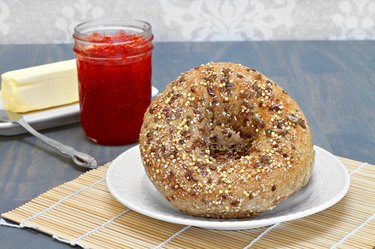
A small oat bran bagel contains 176 calories, 2.5 g of fiber and almost no saturated fat. You can eat bagels on a diabetes diet, but choose whole grain bagels instead of bagels made from processed and refined grains. Balance your bagel – a starchy food – with a variety of other food groups such as fruit, non-starchy vegetables and protein.
Whole Grains versus Refined Grains
Video of the Day
A healthy diabetes diet contains many of the same elements as diets to prevent heart disease, cancer or to maintain a healthy weight. It includes an abundance of nutrients and fiber but limits fat and sodium. Whole grain bagels provide more nutrients and fiber than bagels made from refined grains, such as white flour. Whole grains also provide essential fatty acids, phytochemicals, vitamin and most of the B vitamins. The first ingredient in your bagel should be 100 percent whole wheat flour. Also watch portion sizes. Choose small bagels because they contain fewer carbohydrates than oversized bagels. And count a bagel as two servings of starchy foods.
Video of the Day
Breakfast
Balanced portions from different food groups help keep blood glucose levels from spiking. The balance at breakfast should include 1/2 starchy foods, 1/4 protein and 1/4 fruit, according to the American Diabetes Association. A whole grain bagel can help you meet these guidelines. Top your bagel with 1 oz. of lean ham and eat it with a side of fruit. Stir fresh blueberries or blackberries into low-fat cottage cheese and put the mixture on an open-faced bagel. Spread almond butter on the bagel and top it with fresh slices of banana.
Lunch and Dinner
Your lunch and dinner should include this balance of foods: 1/2 non-starchy vegetables, 1/4 starchy foods and 1/4 protein. A bagel sandwich makes a great lunch or dinner meal option. Top your whole grain bagel with lean, skinless turkey breast for healthy protein. Add a variety of nonstarchy vegetables such as romaine, baby spinach, arugula, onions, tomatoes, sprouts, sweet red pepper, cucumber and celery. Use mustard and fresh ground black pepper for flavor instead of mayonnaise, which tends to contain a lot of saturated fat and calories.
Considerations
Don't forget to include other starchy foods in your diet. Whole grain food items are just one type of starch. A balanced meal plan for diabetes should include starches from other sources such as legumes and starchy vegetables. Examples of healthy non-grain starchy foods include beans, lentils, corn, green peas, sweet potatoes, brown rice, wild rice, parsnip, butternut squash and plantains. If you need help devising an eating plan to control your blood glucose levels and manage your overall health, seek the help of a registered dietitian or other nutrition expert.
- American Diabetes Association: Food and Fitness – Carbohydrates
- American Diabetes Association: Food and Fitness – Whole Grain Foods
- American Diabetes Association: Food and Fitness – Create Your Plate
- American Diabetes Association: Food and Fitness – Non-Starchy Vegetables
- American Dietetic Association; Eat Right: Diabetes and Diet
- United States Department of Agriculture Nutrient Database: Bagels, oat bran